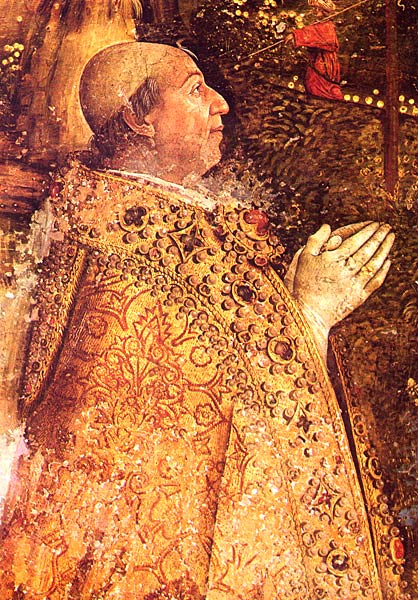The Borgia Pope, Pinturicchio, and Giulia Farnese
In my mind, there's nothing better then some fabulous art, especially when a bit of mystery and scandal are thrown in. That's why I was practically giddy yesterday to be able to see a long-lost work of art with a shocking past.
Back in the 1490s, just around the time a pair of Spanish monarchs sent Christopher Columbus off in search of a new route to India, another famous Spaniard was stepping into the most important shoes in Christendom. Most people are at least somewhat familiar with the notorious Borgia family, and their patriarch Rodrigo, Pope Alexander VI, especially thanks to the Showtime series, but just in case you need a refresher, Alexander VI went down in history as the Papa Cattivo (naughty pope) due to his unprecedented unpriestly lifestyle that included mistresses, many children, nepotism, greed, corruption, orgies, murder, and according to some, incest.
His living quarters in the Vatican Palace, the now-called Borgia Apartment, are decorated with frescoes by the great Renaissance painter Pinturicchio (who also painted some of the wall frescoes in the nearby Sistine Chapel).The most famous is probably The Disputation of St. Catherine that features his famously beautiful young daughter Lucrezia posing as the saint and The Ascension, which features the Pope himself.
But these were not the only portraits the Pope had Pinturicchio slip into his paintings. According to Vasari, the father of art history, "In the palace he also portrayed over the door of one of the living rooms Signora Giulia Farnese in the features of Our Lady and in the same picture the face of Pope Alexander, who is adoring the Madonna," (Giorgio Vasari, Lives of the Artists, Penguin Classics, vol. II, translation by George Bull, pg 83).
This might not have been so scandalous if the Giulia Farnese in question hadn't been the Pope's teenage mistress at the time. It was a well-documented fact that the already married Farnese, called La Bella Farnese and known as being the most beautiful woman in Rome at the time, was not only the Pope's official mistress, but had also borne him child. (Some even supposed that their baby daughter Laura, born in 1492--the very year that Borgia became pope--modelled for the Baby Jesus!)
Scandalous indeed. Only one problem: the fresco doesn't exist. At least not in the Borgia Apartments. In fact, in my copy of The Lives of the Artist, in the notes at the back, the editor states that Vasari was clearly mistaken in what he wrote because the work does not exist. Well, as it turns out, it did exist, but was destroyed.
Nearly 200 years later, during the reign of Pope Alexander VII Chigi (1655-1667) that moralizing pontiff decided a fresco of the "Naughty Pope" adoring his teenage mistress dressed as the Virgin (and possibly their female lovechild) was not only inappropriate for the Vatican, but blasphemous as well. So the fresco was hacked right off the wall. However, it seems that at least a few pieces of the errant work were salvaged by either the Pope himself, or someone in his family, because a small fragment of a fresco depicting an unusually beautiful Christ child held by pair of graceful hands with another hand caressing his foot (eventually dubbed Baby Jesus of the Hands) was listed as part of the collection of Flavio Chigi, relative of the late Alexander VII Chigi, in 1693, as well as a half-figure fresco of the Madonna. Both works were at the time attributed to Perugino.
The two fragments were passed down through the Chigi family, on display at the Palazzo Chigi on Via del Corso, by this time correctly attributed to Pinturicchio, until 1912, when Eleonora Chigi married Enrico Incisa della Rochetta and brought the fragments with her, eventually passing them down to their descendant Marchese Giovanni Incisa della Rochetta, who was also an art historian.
In 1940, Marchese Giovanni, travelling in Mantova, happened to see a painting on canvas that looked very familiar to him. It was the work of a 17th century copyist Pietro Facchetti, who had been commissioned by Francesco IV Gonzaga in 1612 to recreate this scandalous work. The Gonzagas were apparently looking for a way to make fun of their rivals, the Farnese. Contemporary chronicler Stefano Infessura reports that Facchetti managed to gain access to the Borgia Apartment in the Vatican by bribing a guard. Even during the papacy of Paul V, the work was considered inappropriate and therefore had been covered by a veil of fabric. Facchetti convinced the guards to uncover the work and eventually painted a copy. When Marchese Giovanni saw Facchetti's work, and carried out some more research of his own, he concluded that his two fragments were part of the long ago destroyed fresco that had once decorated Rodrigo Borgia's own bedroom. Even if the exact likeness of the Christ figure (and possibly the Madonna figure as well, although we do not have the possibility of knowing) wasn't enough to convince him, the portrait of Alexander VI is almost identical to that in The Ascension.
In 2004, the fragment of Baby Jesus of the Hands resurfaced on the antique market and was purchased by the Guglielmo Giordano Foundation. It is on temporary display in the Palazzo Nuovo of the Capitoline Museums free of charge until 5 February, and I urge you to go see it if you have the chance. Besides the exceptional beauty of the work, the story behind it is truly unique. But a question remains: where is the second fragment, that of the face of the Virgin, i.e. Giulia Farnese? It belongs to a private collector who prefers not to be named.
[UPDATE: The mystery bobs up again in 2017!]
Below is another Madonna and Child, not long ago attributed to Pinturicchio, on display along side the fresco fragment in this mini-mostra. It is tempera on a wood panel and has nothing to do with the other work, but definitely worth seeing.






